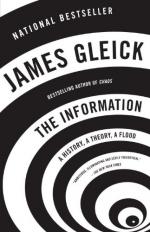
|
| Name: _________________________ | Period: ___________________ |
This test consists of 15 multiple choice questions and 5 short answer questions.
Multiple Choice Questions
1. When were computers first unveiled?
(a) At the end of the Eisenhower administration.
(b) Pre-World War II.
(c) After World War II.
(d) Just before the Korean War.
2. What type of information is contained in DNA?
(a) Information that is limited to the surrounding cells.
(b) Information key to survival.
(c) Information that is passed from generation to generation.
(d) Information that is unique to that organism.
3. What comment did IBM researcher Charles Bennet make about the amount of information in a message?
(a) Is not a good measurement of its importance.
(b) Is not a good measure of its ability for computation.
(c) Is not a good measurement of its meaningfulness.
(d) Is not a good measurement of its capacity.
4. What is DNA also known as?
(a) Amino acid.
(b) Deoxyribonucleic acid.
(c) Cells.
(d) Defining neutrino acid.
5. How are memes replicated?
(a) In response to disease.
(b) Through imitation.
(c) Through cloning.
(d) Through the maturation process.
6. What does the size of the algorithm indicate about the number?
(a) Its simplicity.
(b) Its capacity for computation.
(c) Its computable nature.
(d) Its complexity.
7. What did the study of thermodynamics not state about the movement of energy?
(a) That it traveled in one direction.
(b) That it traveled in many directions.
(c) That it traveled in random directions with no pattern.
(d) That it was dynamic.
8. What does the word "cybernetics" mean?
(a) The study of robotics.
(b) The study of Internet crime.
(c) The same as computer science.
(d) The study of the relationship between man and machine.
9. What time of memory is most limited?
(a) Childhood memory.
(b) Repressed memory.
(c) Short term memory.
(d) Long term memory.
10. Why is the randomness of numbers difficult to define?
(a) Numbers send different messages.
(b) Numbers are infinite.
(c) Numbers have an unpredictability.
(d) A number may be random to some but not to others.
11. What does Gleick compare the "Library of Babel" to?
(a) Search engines.
(b) The M-Theory.
(c) Quantum consciousness.
(d) The Internet.
12. The universe has performed how many "operations"?
(a) 10 to the 100th power "operations."
(b) Over ten trillion "operations."
(c) An infinite number of "operations."
(d) 10 to the 120th power "operations."
13. What happened to the library that once held all known information?
(a) It was destroyed when Sparta burned.
(b) It was burned when Alexandria was conquered.
(c) It was abandoned at Oxford when it was felt that there was too much information to store.
(d) It was buried during an eruption of Etna.
14. Chaotic looking numbers may have simplistic algorithms but why are many difficult to determine?
(a) Because they are not computable.
(b) The number is too difficult to compress through computation.
(c) The number is too complex.
(d) It is impossible to work back from the number to find them.
15. How does Gleick see the universe?
(a) As a cloud of quantum particles.
(b) As a colossal Internet.
(c) As an infinite stream of knowledge.
(d) As a giant computer.
Short Answer Questions
1. What was Rolf Landauer's opinion of John von Neumann's theory on the energy cost of information?
2. "Entropy" was first used by what individual to describe the unavailability of energy?
3. The elements of DNA come in predictable proportions of what shape?
4. What are memes?
5. Why is the belief in God an enduring one?
|
This section contains 561 words (approx. 2 pages at 300 words per page) |

|




